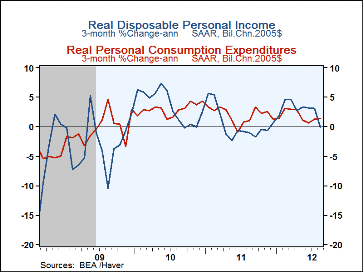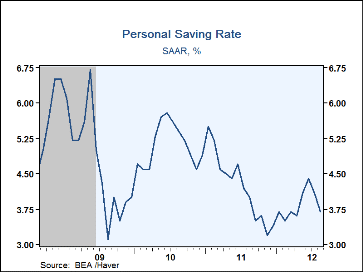 Global| Sep 28 2012
Global| Sep 28 2012U.S. Real Take-home Pay Declines But Consumers Keep Spending
by:Tom Moeller
|in:Economy in Brief
Summary
Adjusted for price inflation, disposable personal income fell 0.3% during August. On a y/y basis, growth held up at 1.8% but three-month growth was slightly negative for the first time since November. The monthly decline reflected a [...]
 Adjusted for price inflation, disposable personal
income fell 0.3% during August. On a y/y basis, growth held up at 1.8%
but three-month growth was slightly negative for the first time since
November. The monthly decline reflected a steady 0.1% gain in nominal
terms. That rise equaled the 0.1% uptick in total personal income which
followed a downwardly revised 0.1% July gain, originally set at
0.3%. A 0.2% advance had been the consensus expectation. A 0.1% (3.7% y/y)
rise in wages followed a like uptick in July and three-month growth was a
diminished 2.4%. Proprietors income rose a firm 0.6% (4.1% y/y) but
interest income fell 1.3% (-1.8% y/y) along with transfer receipts, off
0.1% (+2.7% y/y)
Adjusted for price inflation, disposable personal
income fell 0.3% during August. On a y/y basis, growth held up at 1.8%
but three-month growth was slightly negative for the first time since
November. The monthly decline reflected a steady 0.1% gain in nominal
terms. That rise equaled the 0.1% uptick in total personal income which
followed a downwardly revised 0.1% July gain, originally set at
0.3%. A 0.2% advance had been the consensus expectation. A 0.1% (3.7% y/y)
rise in wages followed a like uptick in July and three-month growth was a
diminished 2.4%. Proprietors income rose a firm 0.6% (4.1% y/y) but
interest income fell 1.3% (-1.8% y/y) along with transfer receipts, off
0.1% (+2.7% y/y)
Despite the decline in real income, inflation adjusted personal consumption expenditures ticked up 0.1% (2.0% y/y) following a 0.4% July rise. However, showing moderation was three-month growth of 1.4% which was half of that six months ago. Nominal spending advanced 0.5% (3.6% y/y) during August. Also adjusted for inflation, spending on goods rose 0.4% (3.8% y/y) last month lifted by strength in vehicle sales (10.6% y/y) and home furnishings & appliances (6.2% y/y). Nondurables spending rose 0.3% (1.9% y/y) with strength in spending on apparel (3.6% y/y) but spending on services slipped 0.1% (+1.1% y/y).
Firm spending growth in the face of a diminished income gain reduced the personal savings rate to 3.7% last month, its lowest since April. However, these figures remain up from November's low of 3.2%.
The PCE chain price index advanced 0.4% (1.5% y/y). The monthly gain matched the strongest since June of 2009. Nondurables costs jumped 1.3% (1.7% y/y) with the rise in gasoline prices. Durable goods prices slipped 0.2% (-1.8% y/y) while services prices increased 0.2% (2.0% y/y). Less food and energy, the PCE chain price index ticked up 0.1% (1.6% y/y) as it did in July.
The personal income & consumption figures are available in Haver's USECON and USNA databases. The consensus expectations figures are in the AS1REPNA database.
| Personal Income & Outlays(%) | Aug | Jul | Jun | Y/Y | 2011 | 2010 | 2009 |
|---|---|---|---|---|---|---|---|
| Personal Income | 0.1 | 0.1 | 0.3 | 3.5 | 5.1 | 3.8 | -4.8 |
| Wages & Salaries | 0.1 | 0.1 | 0.4 | 3.7 | 4.0 | 2.1 | -4.3 |
| Disposable Personal Income | 0.1 | 0.1 | 0.3 | 3.3 | 3.8 | 3.8 | -2.7 |
| Personal Consumption Expenditures | 0.5 | 0.4 | -0.0 | 3.6 | 5.0 | 3.8 | -1.9 |
| Personal Saving Rate | 3.7 | 4.1 | 4.4 | 4.0 (Aug'11) |
4.2 | 5.1 | 4.7 |
| PCE Chain Price Index | 0.4 | 0.0 | 0.1 | 1.5 | 2.4 | 1.9 | 0.1 |
| Less Food & Energy | 0.1 | 0.1 | 0.2 | 1.6 | 1.4 | 1.5 | 1.4 |
| Real Disposable Income | -0.3 | 0.1 | 0.2 | 1.8 | 1.3 | 1.8 | -2.8 |
| Real Personal Consumption Expenditures |
0.1 | 0.4 | -0.1 | 2.0 | 2.5 | 1.8 | -1.9 |
Tom Moeller
AuthorMore in Author Profile »Prior to joining Haver Analytics in 2000, Mr. Moeller worked as the Economist at Chancellor Capital Management from 1985 to 1999. There, he developed comprehensive economic forecasts and interpreted economic data for equity and fixed income portfolio managers. Also at Chancellor, Mr. Moeller worked as an equity analyst and was responsible for researching and rating companies in the economically sensitive automobile and housing industries for investment in Chancellor’s equity portfolio. Prior to joining Chancellor, Mr. Moeller was an Economist at Citibank from 1979 to 1984. He also analyzed pricing behavior in the metals industry for the Council on Wage and Price Stability in Washington, D.C. In 1999, Mr. Moeller received the award for most accurate forecast from the Forecasters' Club of New York. From 1990 to 1992 he was President of the New York Association for Business Economists. Mr. Moeller earned an M.B.A. in Finance from Fordham University, where he graduated in 1987. He holds a Bachelor of Arts in Economics from George Washington University.








